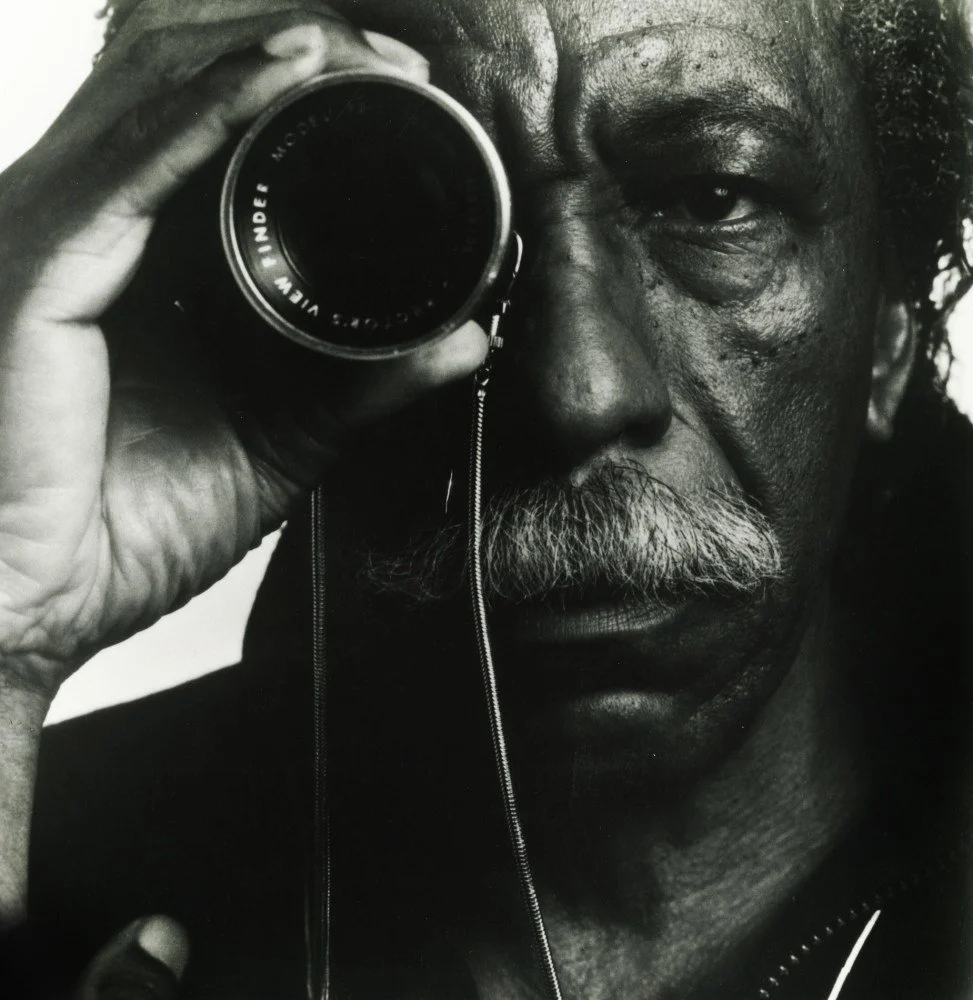
Gordon
Parks
(1912-2006)
American Gothic, Washington, D.C.
1942 (later imp.)
silver print
9-1/3 x 6-3/4 inches
signed
Untitled, n.d. Photograph by Toni Parks
Photographer, filmmaker, composer, and writer, Gordon Parks was one of the most influential American artists of the twentieth century, celebrated for his ability to turn the camera into both a weapon against injustice and a tool for empathy. Born in Fort Scott, Kansas, Parks grew up amid racial segregation and economic hardship, experiences that profoundly shaped his creative vision. Entirely self-taught, he purchased his first camera from a pawnshop in 1937 and began to document scenes of Black life with a sensitivity that countered mainstream depictions of poverty and race.
Parks’s early work led to a fellowship with the Farm Security Administration (FSA) in 1942, where he joined a roster of photographers, including Dorothea Lange and Walker Evans, charged with capturing the realities of American life during the Depression and wartime era. It was during this period that he created one of his most enduring and iconic images, American Gothic, Washington, D.C. (1942).
In that photograph, Ella Watson, a Black government custodian, stands solemnly before an American flag, gripping a broom and mop. Parks deliberately composed the image as a biting visual echo of Grant Wood’s 1930 painting American Gothic. But where Wood’s original symbolized rural fortitude, Parks’s version exposed the bitter irony of American democracy, a nation that espoused equality while relegating many of its citizens to menial labor under the shadow of segregation. The portrait became both a critique and an act of dignity: Parks’s quiet rebellion against systemic racism and his affirmation of Watson’s humanity. He later expanded the concept into a moving photo-essay about her life and family, showing the grace and endurance behind the symbolic image.
Following the FSA, Parks became the first Black photographer for Life magazine, where he chronicled subjects ranging from Harlem street life and civil rights protests to portraits of cultural figures such as Duke Ellington and Muhammad Ali. His storytelling combined photojournalistic precision with cinematic empathy, bridging art and activism. In the 1960s and 1970s, he extended his reach into literature and film, directing The Learning Tree (1969), the first major Hollywood feature directed by an African American, and the influential 1971 film Shaft, which helped define the era’s Black cinema.
Across every medium, Gordon Parks’s work centered on the struggle for dignity and representation. American Gothic, Washington, D.C., remains a cornerstone of American visual culture: a single image that crystallized his lifelong mission to reveal, as he wrote, “the common search for a better life and a better world.”
Selected Exhibitions
Gordon Parks: Half Past Autumn, traveling retrospective organized by the Corcoran Gallery of Art, Washington, D.C., 1997–2000
Gordon Parks: A Segregation Story; High Museum of Art, Atlanta, GA, 2014–15; Crystal Bridges Museum of American Art, Bentonville, AR, 2015
Cross Country: The Power of Place in American Art, 1915-1950; High Museum of Art, Atlanta, GA, 2017
Never a Lovely So Real: Photography and Film in Chicago, 1950-1980; Art Institute of Chicago, IL, 2018
Gordon Parks: The New Tide, Early Work 1940–1950; National Gallery of Art, Washington, D.C., 2018–19; Cleveland Museum of Art, 2019
A Choice of Weapons: Photography and the Civil Rights Struggle, Museum of Fine Arts, Houston, 2020
Gordon Parks in Pittsburgh, 1944/1946; Carnegie Museum of Art, Pittsburgh, PA, 2021
Gordon Parks: I, Too, Am America; Ulrich Museum of Art, Wichita, KS, 2021
Gordon Parks: Born Black; Jack Shainman Gallery, NY, 2024
American Gothic: Gordon Parks and Ella Watson, Minneapolis Institute of Art, MN, 2024
Gordon Parks: Camera Portraits from the Corcoran Collection; National Gallery of Art, Washington, DC, July 14, 2024 - January 12, 2025
Homeward to the Prairie I Come: Gordon Parks Photographs from the Beach Museum of Art; Wichita Art Museum, May 11 -July 27, 2025
To Die or Not
n.d.
photo
13-3/4 x 9-3/4 inches
signed, "Gordon Rogers Parks" in pencil on the mount and titled
